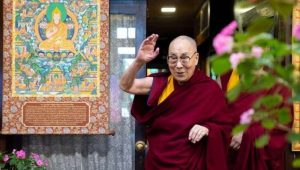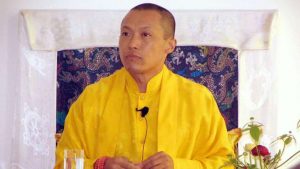There are few better examples of the Mongolian Buddhist heritage than Ikh Khüree, known today as none other than Ulaanbaatar itself, the country’s capital. A seamless fusion of nomadic practicality and Vajrayana Buddhist aesthetics and known alternatively as Urga (Örgöö; palace-yurt), Ikh Khüree was founded in 1639 as a yurt monastery. Its tents served as halls of Tibetan-style practice and ritual, and could be dismantled to be erected elsewhere. Transported by a sizeable retinue of Mongol horses and caravans, Ikh Khüree flourished under the auspices of Öndör Gegeen Zanabazar (1635–1723), an artistic polymath who was also the first recognized reincarnation of the Jebtsundamba Khutuktu (the head of the Gelug school in Mongolia) and a teacher of the Qing dynasty (1644–1911) emperor, Kangxi (r. 1661–1722). It was the center of the Mongol Gelugs, a flourishing nucleus for ethnic Han Chinese artisans, carpenters, and builders of Buddhist art and architecture, and a seat of Manchu administration and Chinese and Russian commerce.
Until its final relocation to the Ulaanbaatar basin in 1855, Ikh Khüree had been moved a staggering 28 times across rivers and mountains. It tragically lost its monastic identity after the confiscation of clerical property in 1921 and the wholesale razing of temples from 1937 to 1938. The world had lost its first and perhaps only mobile theocratic city, a socio-political marvel that has not been replicated anywhere else.
Ikh Khüree’s story is the subject of a forthcoming monograph by Dr. Uranchimeg Tsultem. Dr. Tsultem has spent her career chronicling the evolution of Mongolian painting, which has always been situated in an acute awareness of her cultural inheritance. The loss of so much Buddhist culture during the 20th century bears similar consequences to the gradual erosion of the traditional steppe lifestyle in contemporary Mongolia: a profound dilution of identity that was once taken for granted, as commonplace as the pristine air before Soviet industrialization.
Although Dr. Tsultem first studied European art history during her undergraduate years at ELTE Budapest University, perestroika and Chernobyl profoundly altered her path: unable to finish school in Hungary in 1988, she returned to Mongolia in time for the overthrow of the socialist government in 1989. At a new university at Ulaanbaatar, she switched to
the study of Asian and Mongolian art, and from 1992 to 1993 immersed herself in her Mongolian art scholarship. However, she believes that her late father, Nyam-Osoryn Tsultem (a prominent authority on Mongolian art), inspired her change of direction more than contemporaneous political events. These days, she is undertaking a study of Mongolian Buddhist texts with a year’s grant from the American Council of Learned Societies and The Robert H. N. Ho Family Foundation. The project is a collaborative effort with Vesna Wallace, a prominent Western scholar of Mongolian Buddhism, to translate, research, and write a book about the interplay between Mongolian Buddhist texts and images.
Building on the allusion to the legendary Zanabazar, Buddhist art in Mongolia was a confluence of different disciplines in which sculptors, painters, architects, and scholars could all participate. “Mongolian Buddhist scholars broadly suggest that Buddhism came to the northern nomads in the Mongolian territories by three means: via the Silk Road, during the Mongol imperial period [1206–1368], and throughout the era of the Dalai Lamas [1578–1949],” Dr. Tsultem explains. “The majority of surviving art comes from the 18th century onward.”
The term “Mongolian Buddhist art” is itself slightly misleading—it gives the impression of a unified movement or even school of creativity, when it was really a (brilliantly) eclectic mix of Torgut, Han Chinese, and Mongol talents and specializations coming together over several centuries. Isabelle Charleux notes that Chinese craftsmen and builders made Tibetan-style temples and palaces from the late 16th century onwards, and Chinese immigrants, prisoners, or refugees had a hand in decorating Hohhot Palace in 1572, Chabchiyal Temple in 1577, and many others (Charleux 2010, 3). After the Ming (1368–1644), the Qing dynasty attempted to stop Chinese immigration into Mongolia, but lost control over this policy by the mid-19th century: even today, the legacy of collaboration remains in modern Mongol cities like Tsetserlig, the result of a union between a monastery and a Chinese trade settlement.
While Zanabazar’s privileged role as the “Mongolian Michelangelo” is unmatched—his surviving sculptures are the pinnacle of Mongol craftsmanship, and there are paintings attributed to him as well (Charleux 2010, 16)—Ikh Khüree also enjoyed the presence of accomplished monastic painters (M. zuraach) in the early 19th century. Monk-painters and sketchers like Agwansharav (dates unknown) or Luvsandash (dates unknown) were trained in painting, iconography, and iconometry, the last of which is given huge emphasis in all regional variations of Vajrayana Buddhism (Charleux 2010, 13). Methods of smelting bronze, copper alloy, or brass were taught at foundries, while engravers and painters traveled from temple to temple to work on their sketchbooks. Many owned small workshops, and much like independent artists today, went to markets and fairs to sell their work to laypeople.
The general picture for several centuries of Ikh Khüree’s artistic history, not to say that of other Mongolian cities before the collapse of the Qing and the Russian Revolution, is one of creative chaos, with Han and Mongol smiths, craftsmen, and painters working alongside and competing with each other to construct temples or produce ritual and devotional paraphernalia. They copied manifold techniques from one another for making sculptures, like insetting and gilding. They perfected Tibetan Buddhist iconography, allowing more thangkas, carpets, and metalwork to be sold both in Ikh Khüree and other important cities like Dolonnor (Charleux 2010, 23). This flourishing of religious art production between the 16th and 20th centuries was a collaborative-competitive, inter-ethnic effort on a scale unseen in both Mongolian and Chinese history.
“In Mongolia, as soon as the taboo on religion and the past ended with the fall of the socialist regime in 1990, the whole country—and artists specifically—turned to an in-depth study of its own traditions, history, literature, and old writing. We see how artists are struggling and finding solutions in retrieving traditions from nomadic life and religious values in their contemporary works,” says Dr. Tsultem. After meeting with and corresponding with some of the more prominent contemporary Mongolian artists, I sense that almost all of them are indeed keen to immortalize their steppe culture, from warhorses to jewel-decked princesses. They do this by radically re-interpreting and marketing their motifs and imagery through the use of Western artistic techniques like Impressionism or oil on canvas, and exhibiting these pieces around the world. Artists like Berlin-based Otgonbayar Ershuu (OTGO) (b. 1981) have been particularly successful at this. Yet from what I’ve observed of their art, they have not attempted the same bold reinterpretation with their country’s Buddhist heritage.
While it is completely understandable that artists today focus on the steppe culture that is integral to Mongolian consciousness, perhaps the magic of Ikh Khüree is that it is also part of this creative nostalgia for nomadic life. To invoke once more the vibrancy that characterized the production of Mongolian Buddhist art would surely enrich contemporary Mongolian art immeasurably, adding a spiritual dimension to a growing artistic subculture that is already impressive.
References
Charleux, Isabelle. 2010. “The Making of Mongol Buddhist Art and Architecture.” In Meditation. The Art of Zanabazar and his school, catalogue trilingue (polonaise, anglais, mongol) de exposition éponyme organisée au Asia and Pacific Museum, edited by Elvira Eevr Djaltchinova-Malets, 59–105. Varsovie: The Asia Pacific Museum.















